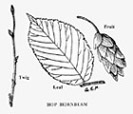American hophornbeam is closely related to the American hornbeam and is rather generally distributed throughout New York State on dry, gravelly, and stony soils of slopes and ridges, sometimes taking possession of woodlots in central New York to the exclusion of other species. The tree is slow-growing and is rarely found larger than 10 inches in diameter. The wood is very heavy, hard, and strong, hence the name "ironwood." It is used for tool and implement handles and for levers, and makes excellent fuelwood when seasoned.
